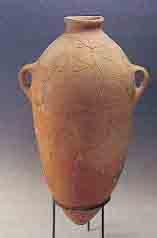Image Details

David Harris
Collar-rim jars. Named after the collar-like ridges at the bottom of their short, wide necks (see detail), these jars had been thought to be a distinguishing feature of Israelite culture in the central highlands of Canaan. Now scholars are no longer so sure, having noted the presence of such jars in non-Israelite locations. As is the case with the Philistines, architectural features and the patterns of settlement are an equally important indication of a particular ethnic group.
The drab and utilitarian appearance of collar-rim jars stands in contrast to the elegant and highly decorated Philistine ware . Collar-rim jars could typically hold 10 to 15 gallons of water and were the principal means of storing or moving water in the central Canaanite highlands until about 1000 B.C. After that time, the widespread use of iron tools made possible the digging of cisterns in bedrock; collar-rim jars fell into disuse, one of history’s early victims of technological advancement.
